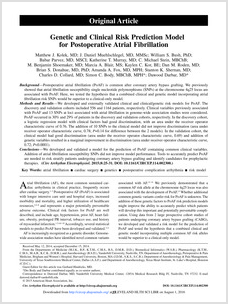Kolek MJ, Muehlschlegel JD, Bush WS, Parvez B, Murray KT, Stein CM, Shoemaker MB, Blair MA, Kor KC, Roden DM, Donahue BS, Fox AA, Shernan SK, Collard CD, Body SC, Darbar D,.
Postoperative atrial fibrillation (PoAF) is common after coronary artery bypass grafting. We previously showed that atrial fibrillation susceptibility single nucleotide polymorphisms (SNPs) at the chromosome 4q25 locus are associated with PoAF. Here, we tested the hypothesis that a combined clinical and genetic model incorporating atrial fibrillation risk SNPs would be superior to a clinical-only model.We developed and externally validated clinical and clinical/genetic risk models for PoAF. The discovery and validation cohorts included 556 and 1164 patients, respectively. Clinical variables previously associated with PoAF and 13 SNPs at loci associated with atrial fibrillation in genome-wide association studies were considered. PoAF occurred in 30% and 29% of patients in the discovery and validation cohorts, respectively. In the discovery cohort, a logistic regression model with clinical factors had good discrimination, with an area under the receiver operator characteristic curve of 0.76. The addition of 10 SNPs to the clinical model did not improve discrimination (area under receiver operator characteristic curve, 0.78; P0.14 for difference between the 2 models). In the validation cohort, the clinical model had good discrimination (area under the receiver operator characteristic curve, 0.69) and addition of genetic variables resulted in a marginal improvement in discrimination (area under receiver operator characteristic curve, 0.72; P0.0001).We developed and validated a model for the prediction of PoAF containing common clinical variables. Addition of atrial fibrillation susceptibility SNPs did not improve model performance. Tools to accurately predict PoAF are needed to risk stratify patients undergoing coronary artery bypass grafting and identify candidates for prophylactic therapies.

